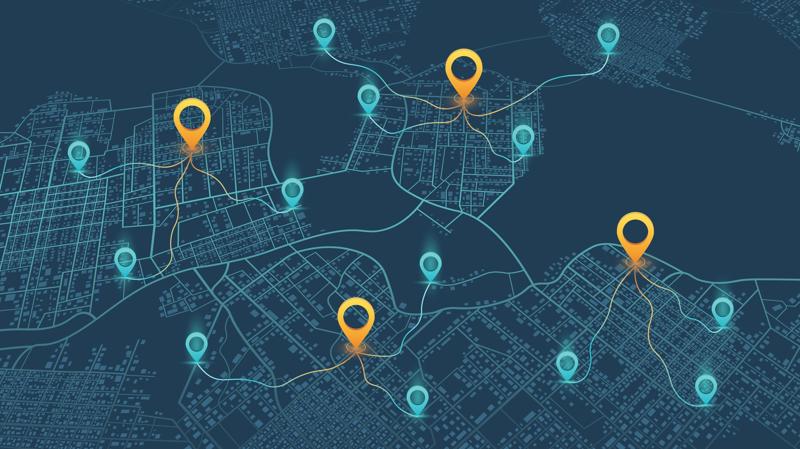Which states are implementing competency-based education assessments? Where can I see this in action?” These are questions we at KnowledgeWorks hear more and more from state and district leaders, educators, and partners in the field—people we’ve been working alongside since 2017. It doesn’t have a simple answer. Although no U.S. state has fully implemented such an assessment system, states are making thoughtful design choices that move schools and districts closer to a future where assessments are more meaningful, competency-based, and student-centered.
At KnowledgeWorks, we have developed eight essential conditions for student success as part of our State Policy Framework for Personalized Learning, and one of them is building a comprehensive system of assessments. (The others are system purpose, policy flexibility, flexible pathways, accountability, educator support, student support, and funding systems.) By comprehensive, we mean a set of assessments that move beyond standardization and narrow determinations of academic proficiency and include formative, benchmark, and summative tasks that give students a variety of ways to demonstrate proficiency across a wide range of knowledge, skills, and dispositions. These assessments should be instructionally embedded, culturally responsive, and co-created with educators.
A comprehensive system of assessments should produce meaningful data that drive instructional improvements and help leaders direct resources to the areas of greatest need. Summative, end-of-year assessments should be streamlined to focus on the most crucial information to monitor core academic trends. Building, district, and state policy leaders should use this information to adjust resources, curriculum, and professional development to improve (1) trends in student growth over time (literacy and numeracy); (2) postsecondary readiness; and (3) graduation completion. Deeper, performance-based benchmark assessments should give teachers and schools actionable information throughout the year to ensure that students are on pace to master essential knowledge and skills in communication, critical thinking, collaboration, and academics, to name a few. States can maintain the quality of this comprehensive system by investing in cutting-edge tools for local assessments, including shared rubrics, transparent criteria, and ongoing research for continuous improvement.
One such innovative resource is the Performance Assessment Resource Bank. Developed through a partnership with SCALE (Systems Change Advancing Learning and Equity) at Stanford University, the Council of Chief State School Officers, Envision Learning Partners, and others, the initiative enables educators to submit performance-based tasks to Stanford experts for validation. Once validated, tasks are added to a publicly accessible bank, offering standards-aligned assessments that any teacher can use and adapt to meet their pacing and instructional goals. When well-designed and thoughtfully integrated into a competency-based instructional approach, assessment systems do more than measure learning—they advance it. They give students voice, support teachers in their practice, and help state leaders understand if the education system is meeting its goals and preparing learners for the future (Pace & Brown, 2022). Because the assessments are clearly delineated at different levels—state, district, local, and classroom—they can be tailored to serve a specific purpose. This helps avoid one of the most common criticisms of summative, state-level assessments: that they try to do too much, and, as a result, fail to meet any objective effectively.
What Is Competency-Based Assessment?
Competency-based assessment is grounded in the belief that students should advance based on their ability to demonstrate proficiency in specific knowledge and skills. The assessments focus on real-world application and deeper learning; they ensure that learners can demonstrate their knowledge and their ability to apply it meaningfully. Unlike traditional assessments where students rely on memorization and standardization, competency-based assessments offer a more dynamic and personalized approach to learning and measurement. Student agency plays a central role. Learners document their own progress and choose how they will demonstrate their knowledge. Whether through projects, presentations, or real-world applications, students can choose options that align with their individual strengths and interests (KnowledgeWorks, 2021).
For competency-based assessments to succeed, they must be co-designed with educators and communities, not imposed on them.
Five Crucial Design Principles
Across the country, states and districts are exploring ways to bring competency-based design principles into their existing assessment systems. Some are taking this on independently, while others are working in partnership with us to design and test new approaches. This momentum toward a more student-centered assessment landscape is growing because of both local innovation and collaborative partnerships. The following five principles work in concert with one another to create more personalized, meaningful, and effective ways to measure student learning.
1. Assessments are instructionally timely.
One of the most promising trends in assessment design involves integrating assessments into the flow of instruction, rather than administering them at the end of a unit or term. Montana is piloting a through-year model—the Montana Alternative Student Testing (MAST) program—across grades 3–8 in English language arts and math that enables educators to administer mini-assessments on clusters of standards when students are ready. These assessments are more responsive to student progress, and they inform teaching and support learning in real time. To avoid double testing, Montana secured a waiver from the U.S. Department of Education to allow participating schools to focus solely on the MAST assessment, instead of having to administer the traditional state summative assessment.
2. Assessments measure higher-order skills.
States are increasingly rethinking their assessment systems to better measure higher-order thinking by moving beyond traditional multiple-choice formats. Massachusetts, as part of its Innovative Science Assessment initiative, has been developing and piloting performance tasks aligned with its science curriculum. Nebraska, as a member of the six-state SIPS (Stackable, Instructionally-Embedded, Portable Science Assessments) consortium, is developing common assessments and instructional resources that incorporate performance tasks and simulations.
At the same time, states like Colorado, Vermont, Virginia, and Kentucky are empowering local districts to develop and implement performance-based assessments that more accurately reflect student mastery. Colorado’s Department of Education has established a menu of career-ready demonstrations that includes performance assessment to show mastery of key knowledge and skills. Vermont has established model performance indicators at the state level that can serve as the basis of local work. Virginia requires every district to implement a performance assessment but provides local flexibility in selecting the grade and subject for that assessment. And Kentucky is supporting local efforts to reimagine assessment and accountability by empowering communities to develop their own Portrait of a Learner competencies and aligned local accountability systems. The state is facilitating rather than mandating this approach by providing the framework and needed resources.
3. Capstones and portfolios promote student choice.
States like Rhode Island, Colorado, and Vermont are embracing student choice using capstones and portfolios, providing opportunities for learners to demonstrate their knowledge in meaningful, personalized ways. Colorado, for example, offers Capstone Implementation Criteria for students who want to take advantage of this option for graduation purposes. These approaches often incorporate open-ended tasks that enable students to explore topics aligned with their interests while showcasing mastery of academic content. By integrating capstones and portfolios into their assessment systems, these states are fostering deeper learning and supporting the development of higher-order skills through authentic, student-driven work.
4. Assessments are instructionally relevant.
Louisiana is leading the way in developing instructionally relevant assessment designs through its innovative, curriculum-embedded English language arts assessments. These assessments ensure that students are tested only on content they’ve had the opportunity to learn. By aligning assessments directly with classroom instruction and pre-identified texts, Louisiana’s model moves away from generic, skills-based tests and toward a more meaningful measure of student learning. The state is developing similar tools for math (KnowledgeWorks, 2023). Although the future of the Louisiana Innovative Assessment Program is still being determined, it has gained national attention as a promising path forward for rethinking assessment systems and can serve as a model for other states to consider (Aldeman, 2024).
These innovations reflect a growing recognition that assessments should be responsive to individual learning progress, not bound by arbitrary timelines.
5. Assessment systems offer flexible testing windows and “testing out” options.
States are beginning to move away from rigid, once-a-year assessments and toward more flexible, student-centered systems that support timely demonstrations of readiness. Montana’s MSAA (Multi-State Alternate Assessment) system offers long testing windows, giving districts the flexibility to assess students when it aligns with instruction rather than on a fixed schedule. Ohio’s Credit Flex policy enables students to earn high school credit by testing out of specific courses, recognizing mastery when it occurs. Similarly, Indiana’s flexible Graduation Pathways initiative includes test-out options as part of a broader effort to personalize learning and assessment. These innovations reflect a growing recognition that assessments should be responsive to individual learning progress, not bound by arbitrary timelines.
Key Challenges to Implementation
Despite growing interest in innovative assessment, efforts at full-scale implementation continue to meet roadblocks. At the state level, funding constraints persist: Most states operate under tight budgets. Federal funding maintains existing systems, but it cannot support the creation of new ones. And although programs like the Competitive Grants for State Assessments and the Innovative Assessment Demonstration Authority (IADA) offer potential, their reach is insufficient. Moreover, the requirements for IADA can inhibit meaningful innovation and overprioritize standardized assessment formats.
Many states find themselves caught in a tension between complying with federal policy and designing systems that reflect meaningful student learning. At the school and classroom levels, the time required to prepare for and administer state tests can crowd out opportunities to implement more authentic, student-centered assessments. Many testing vendors align their benchmark assessments to state tests, leaving districts with few, if any, off-the-shelf options. Even if educators want to innovate, they may not have the resources to do so.
Educators are also navigating reform fatigue. Many are understandably wary of top-down changes that add to their workload without acknowledging the realities of their classrooms. For competency-based assessments to succeed, they must be co-designed with educators and communities, not imposed on them. Building capacity, providing support for implementation, and honoring the professional expertise of teachers will be essential to advancing meaningful and sustainable assessment systems (Pace, 2024).
The rise of artificial intelligence (AI) presents another risk (and benefits). These tools have the potential to quickly and accurately grade performance tasks and even measure skills like collaboration. Initiatives such as Skills for the Future, developed by ETS and the Carnegie Foundation, are already pioneering what this could look like. But realizing AI’s potential for good will require deep expertise and sustained investment. Questions around data privacy, transparency, and usability will become even more urgent for educators as these tools evolve.
What It Will Take
At the core of this shift is the question, Why change? The answer: Because current assessment systems don’t fully capture what students need to succeed and don’t make it easy to try new things. Educators and systems need flexibility and support to design, test, and refine assessments that go beyond traditional measures. The growing movement around Portraits of a Graduate is helping states and districts redefine success (CASEL, 2024). The next step is to build assessment systems that align with these aspirations, ensuring that we measure what matters.
Reimagining assessment isn’t just an education issue; it’s an economic imperative. Business and industry leaders need graduates who are not only academically prepared but also equipped with durable skills—like critical thinking, collaboration, and communication—that help fuel workplace success. According to the Durable Skills Framework from America Succeeds (2024), more than 80 million job postings emphasize the need for these essential competencies.
If we want assessments that serve the needs of all students and promote the skills we most value, it will take bold leadership, sustained investment, and a collective effort. Policymakers must push for better alignment of federal requirements. States must invest in professional development and innovation capacity and must think about both the purpose and the scope of state assessments. Communities must be invited into the design process. And educators, already stretched thin, must be the co-creators of these systems, not just the implementers.
The perfect competency-based assessment system may not yet exist, but many of the pieces are already in place. Now it’s time to align and scale them, not as isolated innovations, but as part of a larger systems transformation that ensures every learner benefits.
Reflect & Discuss
What change in your assessment system would better align your assessments with real-world applications?
Consider the five design principles listed. Which one resonates most with your education philosophy?
What role should educators play in co-creating improved assessments?









